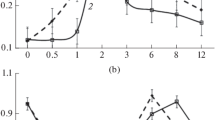Abstract
The membrane fluidity of platelet and erythrocyte membranes in 10 Alzheimer's disease patients and 9 age-matched controls was studied. The platelet membranes of patients with Alzheimer's disease were found to be significantly more fluid than those of controls (p<0.02). However, erythrocyte membranes of Alzheimer patients were less fluid (more viscous) than those of controls (p<0.05). On further investigation of platelet and erythrocyte membranes obtained from healthy volunteers, the fluidity was found to change with increasing aluminium concentrations. When aluminium ammonium sulphate (0.01–10 μM) was added to membrane suspensions, the fluidity of platelet membranes was increased, whereas the fluidity of erythrocyte membranes was decreased (i.e. the microviscosity was increased).
Similar content being viewed by others
References
Graves, A. B., White, E., Koepsell, T. D., Reifler, B. V., Van Belle, G., and Larson, E. B. 1990. The association between aluminum-containing products and Alzheimer's disease. J. Clin. Epidermiol. 43:35–44.
Editorial. 1989. Lancet i:82–83.
Perl, D. P., and Brody, A. R. 1980. Alzheimer's disease: X-ray spectrometric evidence of aluminum accumulation in neurofibrillary tangle-bearing neurons. Science. 208:297–299.
Crapper, D. R., Krishnan, S. S., and Dalton, A. J. 1973. Brain aluminum distribution in Alzheimer's disease and experimental neurofibrillary degeneration. Science. 180:511–513.
Van Rhijn, A., Corrigan, F. M., and Ward, N. I. 1989. Serum aluminum in senile dementia of Alzheimer's type and in multiinfarct dementia. Trace Elem. Med. 6:24–26.
Blass, J. P., Hanin, I., Barclay, L., Kopp, U., and Reding, M. J. 1985. Red blood cell abnormalities in Alzheimer's disease. J. Am. Geriatr. Soc. 33:401–405.
Zubenko, G. S., Cohen, B. M., Reynolds, C. F., Boller, F., Malinakova, I., and Keefe, N. 1987. Platelet membrane fluidity in Alzheimer's disease and major depression. Am. J. Psychiatry 144:860–868.
McKhann, G., Drachman, D., Folstein, M. F., Katzman, R., Price, D., and Stadlan, E. 1984. Clinical diagnosis of Alzheimer's disease: report of the NINCDS-ADRDA work group under the auspices of Department of Health and Human Services Task Force on Alzheimer's Disease. Neurology 34:939–944.
American Psychiatric Association, 1987. DSM-III-R: Diagnostic and Statistical Manual of Mental Disorders. 3rd ed. Revised. APA, Washington DC.
Folstein, M. F., Folstein, S. E., and McHugh, P. R. 1975. “Mini-Mental State”: A practical method for grading the cognitive state of patients for the clinician. J. Psychiatry Res. 12:189–198.
Carstens, M. E., engelbrecht, A. H., Russell, V. A., Aalbers, C., Gagiano, C. A., Chalton, D. O., and Taljaard, J. J. F. 1986. Imipramine binding sites on platelets of patients with major depressive disorder, Psychiatry Res. 18:333–342.
Lowry, O. H., Rosebrough, N. J., Farr, A. L., and Randall, R. J. 1951. Protein measurement with the Folin phenol reagent. J. Biol. Chem. 193:265–275.
Van Blitterswijk, W. J., Van Hoeven, R. P., and Van der Meer, B. W. 1981. Lipid structural order parameters (reciprocal of fluidity) in biomembranes derived from steady-state fluorescence polarization measurements. Biochim. Biophys. Acta 644:323–332.
Shinitzky, M., and Barenholz, Y. 1978. Fluidity parameters of lipid regions determined by fluorescence polarization. Biochim. Biophys. Acta 515:367–394.
Zubenko, G. S., Malinakova, I., and Chojnacki, B. 1987. Proliferation of internal membranes in platelets from patients with Alzheimer's disease. J. Neuropathol. Exp. Neurol. 46:407–418.
Hajimohammardeza, I., Brammer, M. J., Eagger, S., Burns, A., and Levy, R. 1990. Platelet and erythrocyte membrane changes in Alzheimer's disease. Biochim. Biophys. Acta. 1025:208–214.
Weis, C., and Haug, A. 1989. Aluminum-altered membrane dynamics in human red blood cell white ghosts. Thrombosis Res. 54:141–149.
Palade, G. 1975. Intracellular aspects of the process of protein synthesis. Science. 189:347–358.
Orci, L., Ravazzola, M., and Anderson, R. G. W. 1987. The condensing vacuole of exocrine cells is more acidic than the mature secretory vesicle. Nature 326:77–79.
Ferreira, J. A., Carstens, M. E., and Taljaard, J. J. F. 1990. Quantitative determination of lymphocyte ACTH1–39. Neuropeptides 15:11–15.
Martin, R. B. 1986. The chemistry of aluminum as related to biology and medicine. Clin. Chem. 32/10:1797–1806.
Birchall, J. D., and Chappell, J. S. 1988. Aluminium, chemical physiology, and Alzheimer's disease. Lancet ii:1008–1010.
Zubenko, G. S. 1986. Hippocampal membrane alteration in Alzheimer's disease. Brain Res. 385:115–121.
Caron, J. M., and Berlin, R. D. 1987. Dynamic interactions between microtubules and artificial membranes. Biochemistry 26:3681–3688.
Gruca, S., and Wisniewski, H. M. 1984. Cytochemical study on the effect of aluminum on neuronal Golgi apparatus and lysosomes. Acta Neuropathologica 63:287–295.
Farrar, G., Altmann, P., Welch, S., Wychrij, O., Ghose, B., Lejeune, J., Corbett, J., Prasher, V., and Blair J. A. 1990. Defective gallium-transferrin binding in Alzheimer disease and Down syndrome: possible mechanism for accumulation of aluminium in brain. Lancet 335:747–750.
Author information
Authors and Affiliations
Rights and permissions
About this article
Cite this article
van Rensburg, S.J., Carstens, M.E., Potocnik, F.C.V. et al. Membrane fluidity of platelets and erythrocytes in patients with Alzheimer's disease and the effect of small amounts of aluminium on platelet and erythrocyte membranes. Neurochem Res 17, 825–829 (1992). https://doi.org/10.1007/BF00969020
Accepted:
Issue Date:
DOI: https://doi.org/10.1007/BF00969020



